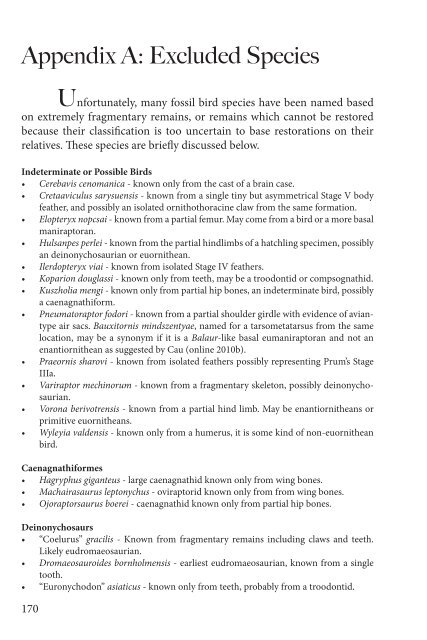Create successful ePaper yourself
Turn your PDF publications into a flip-book with our unique Google optimized e-Paper software.
Appendix A: Excluded Species<br />
Unfortunately, many fossil bird species have been named based<br />
on extremely fragmentary remains, or remains which cannot be res<strong>to</strong>red<br />
because their classification is <strong>to</strong>o uncertain <strong>to</strong> base res<strong>to</strong>rations on their<br />
relatives. These species are briefly discussed below.<br />
Indeterminate or Possible Birds<br />
• Cerebavis cenomanica - known only from the cast of a brain case.<br />
• Cretaaviculus sarysuensis - known from a single tiny but asymmetrical Stage V body<br />
feather, <strong>and</strong> possibly an isolated ornithothoracine claw from the same formation.<br />
• Elopteryx nopcsai - known from a partial femur. May come from a bird or a more basal<br />
manirap<strong>to</strong>ran.<br />
• Hulsanpes perlei - known from the partial hindlimbs of a hatchling specimen, possibly<br />
an deinonychosaurian or euornithean.<br />
• Ilerdopteryx viai - known from isolated Stage IV feathers.<br />
• Koparion douglassi - known only from teeth, may be a troodontid or compsognathid.<br />
• Kuszholia mengi - known only from partial hip bones, an indeterminate bird, possibly<br />
a caenagnathiform.<br />
• Pneuma<strong>to</strong>rap<strong>to</strong>r fodori - known from a partial shoulder girdle with evidence of aviantype<br />
air sacs. Bauxi<strong>to</strong>rnis mindszentyae, named for a tarsometatarsus from the same<br />
location, may be a synonym if it is a Balaur-like basal eumanirap<strong>to</strong>ran <strong>and</strong> not an<br />
enantiornithean as suggested by Cau (online 2010b).<br />
• Praeornis sharovi - known from isolated feathers possibly representing Prum’s Stage<br />
IIIa.<br />
• Varirap<strong>to</strong>r mechinorum - known from a fragmentary skele<strong>to</strong>n, possibly deinonychosaurian.<br />
• Vorona berivotrensis - known from a partial hind limb. May be enantiornitheans or<br />
primitive euornitheans.<br />
• Wyleyia valdensis - known only from a humerus, it is some kind of non-euornithean<br />
bird.<br />
Caenagnathiformes<br />
• Hagryphus giganteus - large caenagnathid known only from wing bones.<br />
• Machairasaurus lep<strong>to</strong>nychus - ovirap<strong>to</strong>rid known only from from wing bones.<br />
• Ojorap<strong>to</strong>rsaurus boerei - caenagnathid known only from partial hip bones.<br />
Deinonychosaurs<br />
• “Coelurus” gracilis - Known from fragmentary remains including claws <strong>and</strong> teeth.<br />
Likely eudromaeosaurian.<br />
• Dromaeosauroides bornholmensis - earliest eudromaeosaurian, known from a single<br />
<strong>to</strong>oth.<br />
• “Euronychodon” asiaticus - known only from teeth, probably from a troodontid.<br />
170



